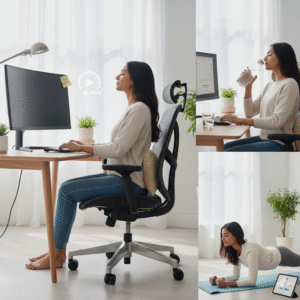
Working from home has become the new normal for many professionals, but long hours at a desk—or worse, on the couch—can take a toll on your posture. Poor posture not only causes back, neck, and shoulder pain but can also lead to fatigue and reduced productivity. The good news? With a few mindful changes, you can significantly improve your posture and prevent long-term discomfort.
1. Set Up an Ergonomic Workspace
A proper workspace setup is the foundation of good posture.
Chair: Choose a chair that supports the natural curve of your spine. Your feet should rest flat on the floor, and your knees should be at a 90° angle.
Desk Height: Keep your elbows close to your body and your forearms parallel to the floor while typing.
Monitor Level: The top of your screen should be at or slightly below eye level to prevent slouching or tilting your head downward.
💡 Tip: If you don’t have an ergonomic chair, use a small pillow for lumbar support.
2. Take Regular Movement Breaks
Sitting for long hours is one of the biggest contributors to poor posture.
Set a timer to remind yourself to stand, stretch, or walk every 30–45 minutes.
Try simple stretches like shoulder rolls, neck rotations, or standing backbends.
Even short breaks improve blood circulation and relieve muscle tension.
3. Practice Core Strengthening Exercises
A strong core supports your spine and helps you maintain an upright posture naturally.
Add these quick exercises to your daily routine:
Planks – Strengthen your abdominal and back muscles.
Bridges – Activate your glutes and lower back.
Seated Marches – Engage your core while sitting.
🧘 Bonus: Yoga poses like Cat-Cow and Child’s Pose also help improve spinal alignment.
4. Be Mindful of Your Sitting Posture
Even with the right setup, posture depends on habits.
Sit with your back straight and shoulders relaxed, not rounded.
Keep both feet flat—avoid crossing your legs for long periods.
Use reminders (sticky notes or apps) to “check your posture” every hour.
5. Adjust Lighting and Screen Brightness
Straining your eyes can cause you to lean forward, leading to neck and upper-back pain.
Ensure your workspace has adequate lighting, and adjust your screen brightness and contrast to prevent hunching.
6. Stay Hydrated and Manage Stress
Dehydration and stress can cause muscle stiffness and tension.
Drink plenty of water throughout the day.
Try deep breathing or short meditation breaks to relax your body and mind.
Conclusion
Improving your posture while working from home doesn’t require a complete lifestyle change—just awareness and small adjustments. By setting up an ergonomic workspace, staying active, and maintaining good habits, you’ll reduce pain, boost energy, and enhance your overall well-being.
💬 Remember: consistency is key—your body will thank you for every mindful adjustment you make.

